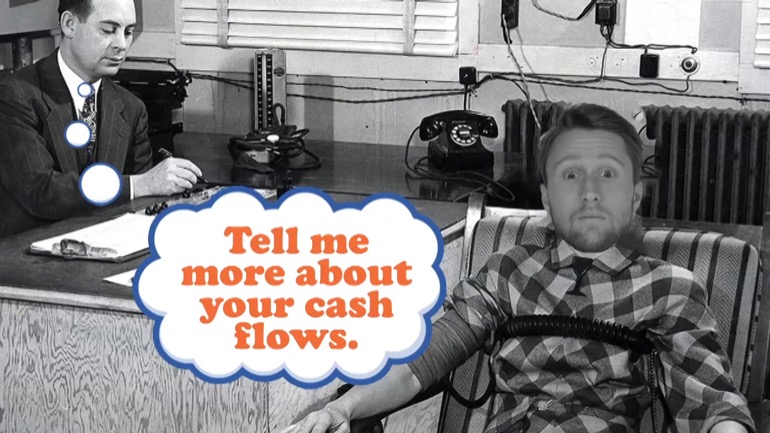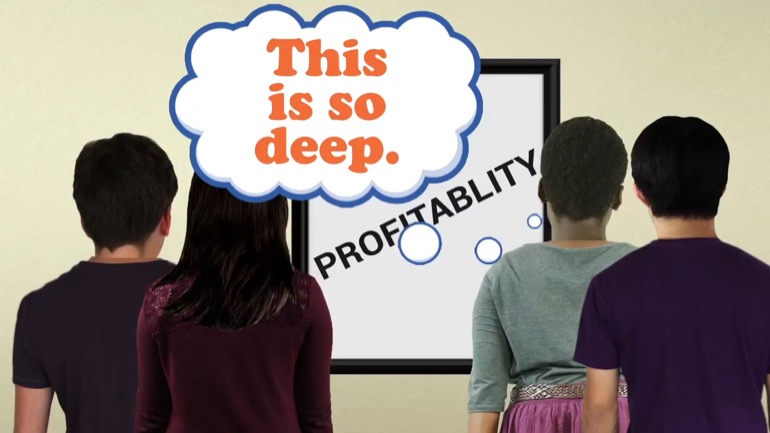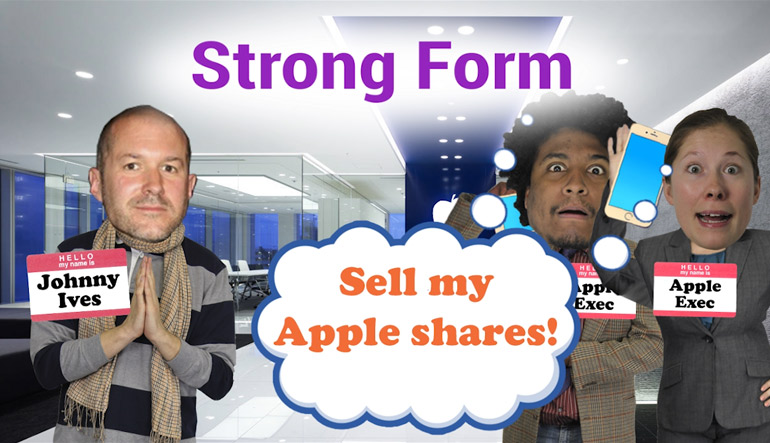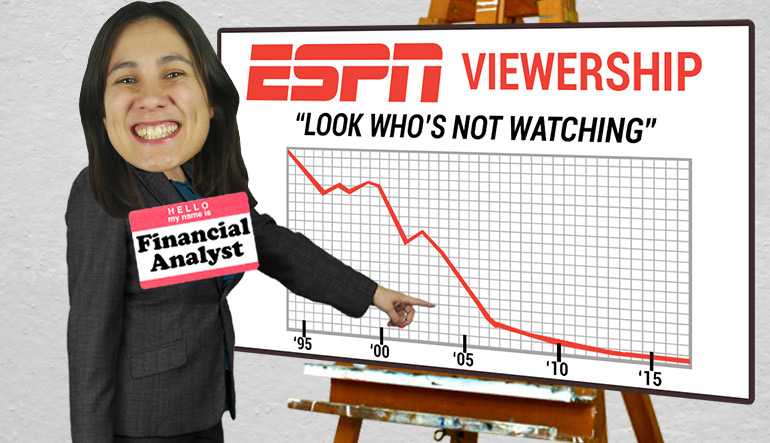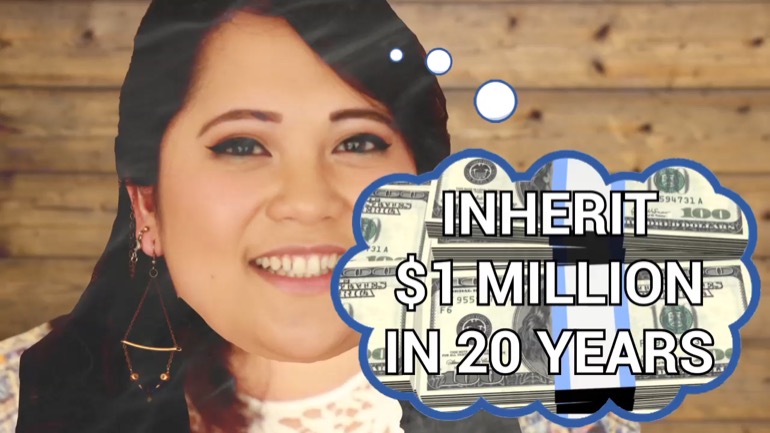ShmoopTube
Where Monty Python meets your 10th grade teacher.
Search Thousands of Shmoop Videos
Principles of Finance Videos 166 videos
How is a company... born? Can it be performed via C-section? Is there a midwife present? Do its parents get in a fight over what to name it? In thi...
Company Formation, Structure, and Inception: Unit Intro. Sorry, Leo DiCaprio fans—we're not going to be breaking down the plot of Inception. We'r...
Okay, so you want to be a company financial manager. It's basically up to you to make money for the shareholders. It would also be swell if you mad...
Principles of Finance: Unit 2, Drill Down on Mutual Funds 3 Views
Share It!
Description:
In this video, we're going to drill down on mutual funds, i.e. funds that achieve one or more mutual goals for its investors.
Transcript
- 00:00
principles of finance a la shmoop drill down on mutual funds all right
- 00:07
yeah that's what we're doing here people mutual mutual funds mutual as in
- 00:11
together with a collective purpose like the members of the mutual admiration [two people admiring each other]
- 00:16
society you have those guys all right well in the finance sense lots of little
- 00:20
gal and guy investors getting together hiring a professional money manager set
Full Transcript
- 00:25
lawyers accountants and others all with the collective goal of having their
- 00:29
capital appreciate in value they're mutually aligned or they could be [pile of money with googly-eyes]
- 00:34
mutually aligned having dividend thrown off in buckets or having a safe preserve
- 00:39
of wealth or else some collection of all the above the goals are all mutual and
- 00:44
with cash contributed from everyone in this financial Stone Soup they have
- 00:49
created a fund and while most funds have a goal they are generally diversified
- 00:54
albeit sometimes inside of a sector think an energy fund a transport fund a [wind turbines, trains, electric wires]
- 01:00
telecommunications technology fund while sector funds are technically mutual
- 01:05
funds well they aren't really diversified and diversifying risk here
- 01:09
is a key element of the mutual fund promise being diversified in tech is
- 01:13
dandy but if that's all you own while you have massive exposure to the tech
- 01:18
sector and if that tanks well so do you yeah in tech it thanks a lot mutual
- 01:24
funds in general is the broad ones offer investors a much more effective way to
- 01:28
diversify their investment holdings and take advantage of the liquidity that a
- 01:33
bunch of people coming together to invest offers they can invest in a broad
- 01:37
range of categories that generally align with the manner in which the S&P 500 is
- 01:42
divided like and well let's check this out so where do you put your hard-earned
- 01:46
savings energy utilities transports bonds stocks tea bills yeah this thing [pie chart]
- 01:52
no not that thing instead of figuring out for yourself what to invest and you
- 01:57
let the experts do it for you at least that's the theory it doesn't always work [woman writes on blackboard]
- 02:01
out that way at least how it was planned on the blackboard because sadly most of
- 02:05
the time well in fact almost all the time the experts are wrong and you do
- 02:09
better off owning an index fund than actually giving your money to a mutual
- 02:12
fund but a little bit of a different story at
- 02:14
least for now mechanically a mutual fund is just an investment company you invest [writing on white board]
- 02:19
by purchasing shares in that investment company and we promise we'll get into
- 02:23
how those shares are priced in a little bit your money and the money from all
- 02:27
the other investors is pooled and then invested by an investment manager and
- 02:32
there are many different investment strategies that mutual funds can adopt
- 02:35
and that the manager will make as they make their investments that are
- 02:39
appropriate for that funds strategy well in return for the investment acumen or
- 02:44
alpha the managers of that fund receive a fee which is calculated usually as a
- 02:49
percentage of the funds it manages like think one percent of the assets under
- 02:53
management or there abouts well mutual funds are governed by the Investment
- 02:57
Company Act of 1940 not active IDEs these investment companies into three
- 03:02
broad categories management investment companies a fancy name for mutual fund
- 03:07
unit investment trusts and face amount certificate companies well the forty Act
- 03:12
sets out a boatload of rules governing mutual funds but one of the most [man on ship with barrels of rules]
- 03:16
important that you need to know is that to be classified as an investment [writing on white board]
- 03:20
company that company has to distribute all income and all gains and losses to
- 03:25
its shareholders in other words it acts as a pass-through for the investors
- 03:30
benefit like they can't just hoard all the cash keep it and say neener neener
- 03:34
so let's take a look at a few types of funds starting with domestic equity
- 03:38
funds well these are stock funds which have a blend of maybe small cap mid cap
- 03:42
and large cap companies in their portfolio with a bias toward growth or
- 03:46
value or a balanced or mixed or blended approach domestic equity funds also
- 03:51
include the various specialties like real estate utilities healthcare [nurse wheeling patient]
- 03:54
commodities Natural Resources technology insurance and banking and so on well
- 04:00
those funds would be targeted or non diversified funds if they generally held
- 04:04
only stocks of companies in that one specific category well what about
- 04:08
international stock funds yep same as domestic funds like domestic funds only
- 04:13
investors generally in us-based companies meaning they're based here but [map of USA with domestic funds getting distributed]
- 04:17
they probably sell their product all over the world there are country
- 04:20
specific funds and funds that can invest in any international company regardless
- 04:25
of where it's in Corp rated you might see a reference to a
- 04:28
global fund the difference between a Global Fund and an international fund is
- 04:32
that while global funds invest here international funds generally don't a
- 04:37
u.s. global fund can invest in Exxon but a u.s. international fund well maybe
- 04:43
can't because Exxon is a domestic company all right moving on that's
- 04:47
enough on stocks and also good bonds we're being very broad here we know this
- 04:51
is just an overview video it's just well a bunch of bonds but bonds generally [writing on whiteboard]
- 04:55
don't include municipal bonds because that's kind of a different category of
- 04:58
bonds because they are tax sheltered meaning there are no tax so generally
- 05:03
muni bonds or for people who pay very high marginal tax rates if you pay low [people paying taxes]
- 05:07
tax rates you'd have no reason to buy immunities so they kind of get
- 05:10
categorized separately well bond funds come in myriad flavors from junk and a
- 05:14
very risky bonds all the way back here to US government issues and generally
- 05:18
very very safe and boring the key distinguishing factors in bond funds are
- 05:22
largely duration that is short medium and long term bond funds the longer the
- 05:28
term of the bond the more exposure there is to credit cycles of the world and to
- 05:32
inflation so longer-term bond funds are generally much more volatile than
- 05:37
short-term ones but the interest rates and longer term bonds are often higher
- 05:41
as certainly in a world where the yield curve is normal making up for that
- 05:45
disparity in the different rates at least to some extent
- 05:48
well what about muni bond funds well their bond funds that only invest in
- 05:52
muni bonds which means they're tax sheltered and not tax-free bonds and you
- 05:56
know the end there for the high earners and good for them all right moving on [women clinking wine glasses]
- 05:59
next up is a classic money market fund well mm F's are actually a huge category [writing on white board]
- 06:05
but they're just bond funds with very short-term durations and in theory very
- 06:09
low levels of risk as well usually they're sold no load money market funds [man jumps of diving board into pool]
- 06:14
are strategically important to mutual funds as a business because customers
- 06:17
like to use them as a jumping off or jumping on vehicle when they make a
- 06:21
commitment to a mutual fund like they wire in the cash through the money
- 06:26
market front it sits there awhile while they're shopping for the specific mutual
- 06:29
fund they want to buy and then they just transfer the dough got it and when you
- 06:33
think about it well for mutual funds mm F's are a kind of airport for the [money man running around in airport]
- 06:38
- wanting to be spent on tourism alright next balanced funds yes he were gonna do
- 06:42
a mashup here of bonds and stocks well there are thousands of mixes that is one [woman mixing ingredients in bowl]
- 06:47
fund ISM a B 30 percent u.s. domestic equities and seventy percent u.s.
- 06:52
domestic bonds others have blends of international equity and bonds and
- 06:57
domestic stocks and bonds and so on and the ratios are just all over the place
- 07:01
and they try to balance on some fulcrum that their marketing literature defines
- 07:06
but they're all mutual funds and they all have their own particular set of
- 07:09
strictures all right moving on finally let's talk about mutual fund [writing on white board]
- 07:13
diversification all right this is the seventy five five ten rule the
- 07:17
Investment Company Act of 1940 has a whole bunch of rules which define what
- 07:21
mutual funds are and are not and they set guidelines as to how they can behave
- 07:25
and structure themselves well a diversified fund means that the fund is
- 07:30
exposed to many areas like energy telecommunications the consumer banks
- 07:34
technology and so on in theory a diversified fund is less volatile than a
- 07:39
non diversified fund for a fun to qualify to be able to advertise itself
- 07:44
as being diversified which old people here as well that's a lot less risk than [old man on screen]
- 07:49
right well seventy five percent of its investment capital must be in no more
- 07:53
than five percent positions in any one security like it can't be too
- 07:58
concentrated into one thing and yes you might ask well what if it was half in
- 08:02
Amazon for a last decade or two yes that would be good but that would have not [pie chart]
- 08:07
been diversified and followed the 1940 rules it also can't own more than ten
- 08:11
percent of any one company's outstanding shares why would that be a rule in this
- 08:15
seventy five ten thing if the company ever needs to sell those shares and be
- 08:19
liquid goes big redemption of mutual fund shares and they need the cash to
- 08:23
give exiting investors their cash well ten percent position is probably
- 08:27
illiquid they need a whole big haircut then to get there right but note that
- 08:30
for twenty five percent of the portfolio the fund can quote violate unquote these man with diversified fund bag for a head]
- 08:36
diversification rules tagged under the 75 percent umbrella right so there's
- 08:40
some wiggle room like if a portfolio manager wants to
- 08:42
take a huge bet on something dot-com thinking it's gonna go up a whole lot
- 08:46
and move the fund well they can do that well a common test question that you'll
- 08:49
get if you ever get tested on this stuff relates to the
- 08:52
maximum that a fund can own of one security and still call itself
- 08:56
diversified and the answer is usually thirty percent not twenty five a non
- 09:01
diversified fund is one that fails that seventy five five ten tests that works
- 09:07
there it's everything else which may be misleadingly narrow as many technically
- 09:12
non-diversified funds are actually highly diversified but because a bunch
- 09:16
of narrow do Wells messed with our system so heavily in the roaring 20s [party in the dark]
- 09:20
well rules have to be created and policed with rigor so yeah that's an
- 09:24
overview of mutual funds we'll have a whole lot more about this for you now
- 09:27
feel free to join the I don't know new the shmoop mutual fund admiration
- 09:31
society is that a thing [mutual fund joins mutual admiration society]
Related Videos
GED Social Studies 1.1 Civics and Government
What is bankruptcy? Deadbeats who can't pay their bills declare bankruptcy. Either they borrowed too much money, or the business fell apart. They t...
What's a dividend? At will, the board of directors can pay a dividend on common stock. Usually, that payout is some percentage less than 100 of ear...
How are risk and reward related? Take more risk, expect more reward. A lottery ticket might be worth a billion dollars, but if the odds are one in...



















































